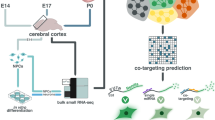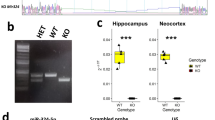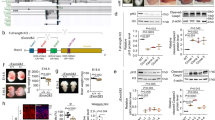Abstract
MicroRNAs function as negative regulators of posttranscriptional gene expression, having major roles in cellular differentiation. Several neuroblastoma cell lines can be induced to undergo differentiation by all-trans-retinoic acid (ATRA) and are used for modeling signaling pathways involved in this process. To identify miRNAs contributing to differentiation, we profiled 364 loci following ATRA treatment of neuroblastoma cell lines and found miR-10a and miR-10b to be highly overexpressed in SK-N-BE, LAN5 and SHSY-5Y. Ectopic overexpression of these miRNAs led to a major reprogramming of the transcriptome and a differentiated phenotype that was similar to that induced by ATRA in each of these cell lines. One of the predicted downregulated miR-10a/b targets was nuclear receptor corepressor 2 (NCOR2), a corepressor of gene transcription, which is known to suppress neurite outgrowth. NCOR2 was experimentally validated as a direct target of miR-10a/b, and siRNA-mediated inhibition of this mRNA alone resulted in neural cell differentiation. Moreover, induction of differentiation could be blocked by ectopic upregulation of NCOR2 using an expression construct lacking the miR-10a/b 3′ untranslated region target site. We conclude that miR-10a/b has major roles in the process of neural cell differentiation through direct targeting of NCOR2, which in turn induces a cascade of primary and secondary transcriptional alterations, including the downregulation of MYCN.
Similar content being viewed by others
Log in or create a free account to read this content
Gain free access to this article, as well as selected content from this journal and more on nature.com
or
Abbreviations
- ATRA:
-
all-trans-retinoic acid
- NCOR2:
-
nuclear receptor co-repressor 2
- MYCN:
-
v-myc myelocytomatosis viral related oncogene
- HOX:
-
homeobox gene
- TUBB3, tubulin:
-
beta 3
- GAP43:
-
growth associated protein 43
- miRNA:
-
microRNA
- miR:
-
microRNA
- UTR:
-
untranslated regions
- GO:
-
gene ontology
References
Baek D, Villen J, Shin C, Camargo FD, Gygi SP, Bartel DP . The impact of microRNAs on protein output. Nature 2008; 455: 64–71.
Bartel DP . MicroRNAs: genomics, biogenesis, mechanism, and function. Cell 2004; 116: 281–297.
Lim LP, Lau NC, Garrett-Engele P, Grimson A, Schelter JM, Castle J et al. Microarray analysis shows that some microRNAs downregulate large numbers of target mRNAs. Nature 2005; 433: 769–773.
Miska EA, Alvarez-Saavedra E, Townsend M, Yoshii A, Sestan N, Rakic P et al. Microarray analysis of microRNA expression in the developing mammalian brain. Genome Biol 2004; 5: R68.
Sempere LF, Freemantle S, Pitha-Rowe I, Moss E, Dmitrovsky E, Ambros V . Expression profiling of mammalian microRNAs uncovers a subset of brain-expressed microRNAs with possible roles in murine and human neuronal differentiation. Genome Biol 2004; 5: R13.
Li X, Jin P . Roles of small regulatory RNAs in determining neuronal identity. Nat Rev Neurosci 2010; 11: 329–338.
Edsjo A, Holmquist L, Pahlman S . Neuroblastoma as an experimental model for neuronal differentiation and hypoxia-induced tumor cell dedifferentiation. Semin Cancer Biol 2007; 17: 248–256.
Nagai J, Yazawa T, Okudela K, Kigasawa H, Kitamura H, Osaka H . Retinoic acid induces neuroblastoma cell death by inhibiting proteasomal degradation of retinoic acid receptor alpha. Cancer Res 2004; 64: 7910–7917.
Chen Y, Stallings RL . Differential patterns of microRNA expression in neuroblastoma are correlated with prognosis, differentiation, and apoptosis. Cancer Res 2007; 67: 976–983.
Thiele CJ, Reynolds CP, Israel MA . Decreased expression of N-myc precedes retinoic acid-induced morphological differentiation of human neuroblastoma. Nature 1985; 313: 404–406.
Seeger RC, Brodeur GM, Sather H, Dalton A, Siegel SE, Wong KY et al. Association of multiple copies of the N-myc oncogene with rapid progression of neuroblastomas. N Engl J Med 1985; 313: 1111–1116.
Brodeur GM, Seeger RC, Schwab M, Varmus HE, Bishop JM . Amplification of N-myc in untreated human neuroblastomas correlates with advanced disease stage. Science 1984; 224: 1121–1124.
Laneve P, Di Marcotullio L, Gioia U, Fiori ME, Ferretti E, Gulino A et al. The interplay between microRNAs and the neurotrophin receptor tropomyosin-related kinase C controls proliferation of human neuroblastoma cells. Proc Natl Acad Sci USA 2007; 104: 7957–7962.
Le MT, Xie H, Zhou B, Chia PH, Rizk P, Um M et al. MicroRNA-125b promotes neuronal differentiation in human cells by repressing multiple targets. Mol Cell Biol 2009; 29: 5290–5305.
Evangelisti C, Florian MC, Massimi I, Dominici C, Giannini G, Galardi S et al. MiR-128 up-regulation inhibits Reelin and DCX expression and reduces neuroblastoma cell motility and invasiveness. FASEB J 2009; 23: 4276–4287.
Beveridge NJ, Tooney PA, Carroll AP, Tran N, Cairns MJ . Down-regulation of miR-17 family expression in response to retinoic acid induced neuronal differentiation. Cell Signal 2009; 21: 1837–1845.
Loven J, Zinin N, Wahlstrom T, Muller I, Brodin P, Fredlund E et al. MYCN-regulated microRNAs repress estrogen receptor-alpha (ESR1) expression and neuronal differentiation in human neuroblastoma. Proc Natl Acad Sci USA 2010; 107: 1553–1558.
Chen H, Shalom-Feuerstein R, Riley J, Zhang SD, Tucci P, Agostini M et al. miR-7 and miR-214 are specifically expressed during neuroblastoma differentiation, cortical development and embryonic stem cells differentiation, and control neurite outgrowth in vitro. Biochem Biophys Res Commun 2010; 394: 921–927.
Das S, Foley N, Bryan K, Watters KM, Bray I, Murphy DM et al. MicroRNA mediates DNA demethylation events triggered by retinoic acid during neuroblastoma cell differentiation. Cancer Res 2010; 70: 7874–7881.
Shah N, Sukumar S . The Hox genes and their roles in oncogenesis. Nat Rev Cancer 2010; 10: 361–371.
Garzon R, Pichiorri F, Palumbo T, Iuliano R, Cimmino A, Aqeilan R et al. MicroRNA fingerprints during human megakaryocytopoiesis. Proc Natl Acad Sci USA 2006; 103: 5078–5083.
Ma L, Reinhardt F, Pan E, Soutschek J, Bhat B, Marcusson EG et al. Therapeutic silencing of miR-10b inhibits metastasis in a mouse mammary tumor model. Nat Biotechnol 2010; 28: 341–347.
Tsang J, Zhu J, van Oudenaarden A . MicroRNA-mediated feedback and feedforward loops are recurrent network motifs in mammals. Mol Cell 2007; 26: 753–767.
Jepsen K, Solum D, Zhou T, McEvilly RJ, Kim HJ, Glass CK et al. SMRT-mediated repression of an H3K27 demethylase in progression from neural stem cell to neuron. Nature 2007; 450: 415–419.
Buckley PG, Alcock L, Bryan K, Bray I, Schulte JH, Schramm A et al. Chromosomal and miRNA expression patterns reveal biologically distinct subgroups of 11q- neuroblastoma. Clin Cancer Res 2010; 16: 2971–2978.
Fischer M, Bauer T, Oberthur A, Hero B, Theissen J, Ehrich M et al. Integrated genomic profiling identifies two distinct molecular subtypes with divergent outcome in neuroblastoma with loss of chromosome 11q. Oncogene 2010; 29: 865–875.
Chen JD, Evans RM . A transcriptional co-repressor that interacts with nuclear hormone receptors. Nature 1995; 377: 454–457.
Chen JD, Umesono K, Evans RM . SMRT isoforms mediate repression and anti-repression of nuclear receptor heterodimers. Proc Natl Acad Sci USA 1996; 93: 7567–7571.
Nagy L, Kao HY, Chakravarti D, Lin RJ, Hassig CA, Ayer DE et al. Nuclear receptor repression mediated by a complex containing SMRT, mSin3A, and histone deacetylase. Cell 1997; 89: 373–380.
Weiss FU, Marques IJ, Woltering JM, Vlecken DH, Aghdassi A, Partecke LI et al. Retinoic acid receptor antagonists inhibit miR-10a expression and block metastatic behavior of pancreatic cancer. Gastroenterology 2009; 137: 2136–2145 e2131-2137.
Agirre X, Jimenez-Velasco A, San Jose-Eneriz E, Garate L, Bandres E, Cordeu L et al. Down-regulation of hsa-miR-10a in chronic myeloid leukemia CD34+ cells increases USF2-mediated cell growth. Mol Cancer Res 2008; 6: 1830–1840.
Lund AH . miR-10 in development and cancer. Cell Death Differ 2010; 17: 209–214.
Ma L, Teruya-Feldstein J, Weinberg RA . Tumour invasion and metastasis initiated by microRNA-10b in breast cancer. Nature 2007; 449: 682–688.
Gee HE, Camps C, Buffa FM, Colella S, Sheldon H, Gleadle JM et al. MicroRNA-10b and breast cancer metastasis. Nature 2008; 455: E8–E9; author reply E9.
Irizarry RA, Hobbs B, Collin F, Beazer-Barclay YD, Antonellis KJ, Scherf U et al. Exploration, normalization, and summaries of high density oligonucleotide array probe level data. Biostatistics 2003; 4: 249–264.
Selzer RR, Richmond TA, Pofahl NJ, Green RD, Eis PS, Nair P et al. Analysis of chromosome breakpoints in neuroblastoma at sub-kilobase resolution using fine-tiling oligonucleotide array CGH. Genes Chromosomes Cancer 2005; 44: 305–319.
Acknowledgements
This work was supported in part by Science Foundation Ireland (07/IN.1/B1776), Children's Medical and Research Foundation, Cancer Research Ireland and the US National Institutes of Health (5R01CA127496). TB was supported by a Marie Curie Cofund EU Fellowship (CEMP; jointly funded by the National Biophotonics and Imaging Platform, Higher Education Authority, Ireland).
Author information
Authors and Affiliations
Corresponding author
Ethics declarations
Competing interests
The authors declare no conflict of interest.
Additional information
Edited by RA Knight
Supplementary Information accompanies the paper on Cell Death and Differentiation website
Supplementary information
Rights and permissions
About this article
Cite this article
Foley, N., Bray, I., Watters, K. et al. MicroRNAs 10a and 10b are potent inducers of neuroblastoma cell differentiation through targeting of nuclear receptor corepressor 2. Cell Death Differ 18, 1089–1098 (2011). https://doi.org/10.1038/cdd.2010.172
Received:
Revised:
Accepted:
Published:
Issue date:
DOI: https://doi.org/10.1038/cdd.2010.172
Keywords
This article is cited by
-
Targeting the epigenome of cancer stem cells in pediatric nervous system tumors
Molecular and Cellular Biochemistry (2023)
-
MicroRNAs as prospective biomarkers, therapeutic targets and pharmaceuticals in neuroblastoma
Molecular Biology Reports (2023)
-
METTL1 promotes neuroblastoma development through m7G tRNA modification and selective oncogenic gene translation
Biomarker Research (2022)
-
Studies on Regulation of Global Protein Profile and Cellular Bioenergetics of Differentiating SH-SY5Y Cells
Molecular Neurobiology (2022)
-
Fenretinide reduces angiogenesis by downregulating CDH5, FOXM1 and eNOS genes and suppressing microRNA-10b
Molecular Biology Reports (2020)



